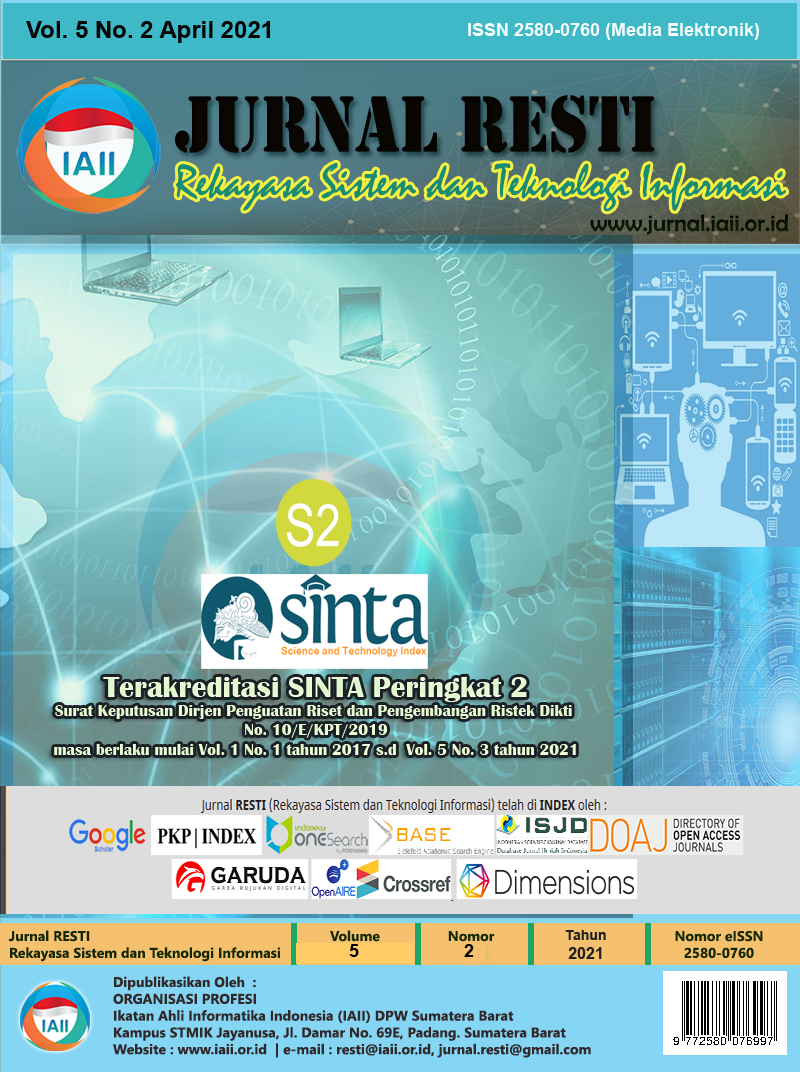Random Forest Algorithm to Investigate the Case of Acute Coronary Syndrome
Abstract
This paper explains the use of the Random Forest Algorithm to investigate the Case of Acute Coronary Syndrome (ACS). The objectives of this study are to review the evaluation of the use of data science techniques and machine learning algorithms in creating a model that can classify whether or not cases of acute coronary syndrome occur. The research method used in this study refers to the IBM Foundational Methodology for Data Science, include: i) inventorying dataset about ACS, ii) preprocessing for the data into four sub-processes, i.e. requirements, collection, understanding, and preparation, iii) determination of RFA, i.e. the "n" of the tree which will form a forest and forming trees from the random forest that has been created, and iv) determination of the model evaluation and result in analysis based on Python programming language. Based on the experiments that the learning have been conducted using a random forest machine-learning algorithm with an n-estimator value of 100 and each tree's depth (max depth) with a value of 4, learning scenarios of 70:30, 80:20, and 90:10 on 444 cases of acute coronary syndrome data. The results show that the 70:30 scenario model has the best results, with an accuracy value of 83.45%, a precision value of 85%, and a recall value of 92.4%. Conclusions obtained from the experiment results were evaluated with various statistical metrics (accuracy, precision, and recall) in each learning scenario on 444 cases of acute coronary syndrome data with a cross-validation value of 10 fold.
Downloads
References
Z. Masetic and A. Subasi, “Congestive Heart Failure Detection Using Random Forest Classifier,” Comput. Methods Programs Biomed., vol. 130, pp. 54–64, 2016, doi: 10.1016/j.cmpb.2016.03.020.
T. I. Rohan, Awan-Ur-Rahman, A. B. Siddik, M. Islam, and M. S. U. Yusuf, “A Precise Breast Cancer Detection Approach Using Ensemble of Random Forest with AdaBoost,” in 5th International Conference on Computer, Communication, Chemical, Materials and Electronic Engineering, IC4ME2 2019, 2019, no. June 2020, pp. 10–14, doi: 10.1109/IC4ME247184.2019.9036697.
H. Byeon, “Is the Random Forest Algorithm Suitable for Predicting Parkinson’s Disease with Mild Cognitive Impairment Out of Parkinson’s Disease with Normal Cognition?,” Int. J. Environ. Res. Public Health, vol. 17, no. 7, pp. 1–14, 2020, doi: 10.3390/ijerph17072594.
A. M. Antoniadi, M. Galvin, M. Heverin, O. Hardiman, and C. Mooney, “Prediction of Caregiver Burden in Amyotrophic Lateral Sclerosis: A Machine Learning Approach Using Random Forests Applied to A Cohort Study,” BMJ Open, vol. 10, no. 2, pp. 1–8, 2020, doi: 10.1136/bmjopen-2019-033109.
K. K. Chari, M. Chinna Babu, and S. Kodati, “Classification of Diabetes Using Random Forest with Feature Selection Algorithm,” Int. J. Innov. Technol. Explor. Eng., vol. 9, no. 1, pp. 1295–1300, 2019, doi: 10.35940/ijitee.L3595.119119.
B. Dai, R. C. Chen, S. Z. Zhu, and W. W. Zhang, “Using Random Forest Algorithm for Breast Cancer Diagnosis,” in International Symposium on Computer, Consumer and Control (IS3C), 2018, pp. 449–452, doi: 10.1109/IS3C.2018.00119.
C. Iwendi et al., “COVID-19 Patient Health Prediction Using Boosted Random Forest Algorithm,” Front. Public Heal., vol. 8, no. July, pp. 1–9, 2020, doi: 10.3389/fpubh.2020.00357.
M. Z. Alam, M. S. Rahman, and M. S. Rahman, “A Random Forest Based Predictor for Medical Data Classification Using Feature Ranking,” Informatics Med., vol. 15, no. April, pp. 1–12, 2019, doi: 10.1016/j.imu.2019.100180.
P. Kaur, R. Kumar, and M. Kumar, “A Healthcare Monitoring System Using Random Forest and Internet of Things (IoT),” Multimed. Tools Appl., vol. 78, no. 14, pp. 19905–19916, 2019, doi: 10.1007/s11042-019-7327-8.
J. Ricordeau and J. Lacaille, “Application of Random Forests To Engine,” in International Congress of the Aeronautical Sciences (ICAS), 2010, no. April, pp. 1–10.
K. Kumar, “Health Care Analysis Using Random Forest Algorithm,” J. Chem. Pharm. Sci., vol. 10, no. 3, pp. 1359–1361, 2017.
O. Pauly, “Random Forests for Medical Applications,” Technischen Universität München, 2012.
L. Pierson, Data Science for Dummies, 2nd ed. New Jersey: John Wiley & Sons Inc., 2017.
Y. Liu, Python Machine Learning By Example - Second Edition, 1st ed. Birmingham: Packt Publishing, 2017.
P. Mathur, Machine Learning Applications Using Python, 1st ed. Karnataka: Apress Media LLC, 2019.
M. Kubat, An Introduction to Machine Learning, 2nd ed. Switzerland: Springer International Publishing AG, 2017.
E. Corbett, “The Real-World Benefits of Machine Learning in Healthcare,” 2017. https://www.healthcatalyst.com/clinical-applications-of-machine-learning-in-healthcare (accessed Mar. 06, 2021).
W. H. Organization, “Cardiovascular diseases,” 2017. https://www.who.int/en/news-room/fact-sheets/detail/cardiovascular-diseases-(cvds) (accessed Mar. 27, 2021).
K. Akyol, E. Çalik, Ş. Bayir, B. Şen, and A. Çavuşoʇlu, “Analysis of Demographic Characteristics Creating Coronary Artery Disease Susceptibility Using Random Forests Classifier,” in International Conference on Soft Computing and Software Engineering (SCSE), 2015, vol. 62, pp. 39–46, doi: 10.1016/j.procs.2015.08.407.
I. Yekkala and S. Dixit, “Prediction of Heart Disease Using Random Forest and Rough Set Based Feature Selection,” Int. J. Big Data Anal. Healthc., vol. 3, no. 1, pp. 1–12, 2018, doi: 10.4018/ijbdah.2018010101.
R. Ani, A. Augustine, N. C. Akhil, and O. S. Deepa, “Random Forest Ensemble Classifier to Predict the Coronary Heart Disease Using Risk Factors,” in International Conference on Soft Computing System, Advances in Intelligent Systems and Computing, 2016, vol. 397, pp. 701–710, doi: 10.1007/978-81-322-2671-0_66.
S. Polamuri, “How The Random Forest Algorithm Works in Machine Learning,” 2017. https://dataaspirant.com/random-forest-algorithm-machine-learing/ (accessed Mar. 06, 2021).
J. Novakovic, A. Veljovi, S. Iiic, Z. Papic, and M. Tomovic, “Evaluation of Classification Models in Machine Learning,” Theory Appl. Math. Comput. Sci., vol. 7, no. 1, pp. 39–46, 2017, [Online]. Available: https://uav.ro/applications/se/journal/index.php/TAMCS/article/view/158.
Copyright (c) 2021 Jurnal RESTI (Rekayasa Sistem dan Teknologi Informasi)

This work is licensed under a Creative Commons Attribution 4.0 International License.
Copyright in each article belongs to the author
- The author acknowledges that the RESTI Journal (System Engineering and Information Technology) is the first publisher to publish with a license Creative Commons Attribution 4.0 International License.
- Authors can enter writing separately, arrange the non-exclusive distribution of manuscripts that have been published in this journal into other versions (eg sent to the author's institutional repository, publication in a book, etc.), by acknowledging that the manuscript has been published for the first time in the RESTI (Rekayasa Sistem dan Teknologi Informasi) journal ;








